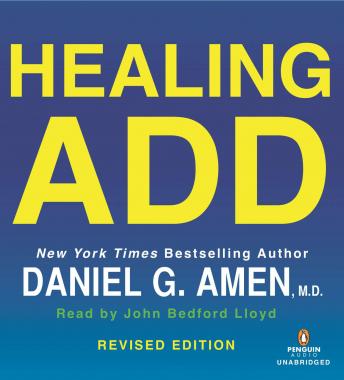

show aired on PBS (or rather, infomercial) about his theories, paid motivational speaker, and master salesman promoting proprietary nutritional supplements. A media star, best-selling author of 30 books (5 New York Times bestsellers), producer of a t.v. Daniel Amen’s Brain Clinics and how they purport to diagnose and cure ADHD.ĭr. The last blog (Part 1) was on vision therapy as a cure for dyslexia.
#Daniel g.amen add test series
MRI does not give any information on function.I’ve decided this series on alternative therapies will first tackle the mistakes I made myself as a parent. Both SPECT and PET scans show areas of the brain that are healthy, overactive, or underactive. PET, another nuclear imaging technique, is similar to SPECT but is a more costly imagining technique. However, whereas MRI shows the physical anatomy or structure of the brain, SPECT shows how the brain works. How SPECT Differs from MRI, fMRI, and PETĪ SPECT scan is similar to an MRI study in that both can show 3D images of the brain.

In a healthy scan, the most active area is in the cerebellum, at the back/bottom part of the brain, which makes up just 10% of the brain’s volume but houses half of the brain’s neurons. Here blue is average activity and red (or sometimes red and white) are the most active parts of the brain. Surface scans help us see areas that are healthy and those with low activity.Ī healthy “active” scan shows the most active parts of the brain. The color is not important, it’s the shape that matters. There are two types of brain SPECT scans, a “surface” scan and an “active” scan.Ī healthy “surface” scan, looking down from the top, shows full, even symmetrical activity. Equally important is the need for consistency in imaging techniques among patients so results are quantifiable, repeatable, and consistent. And 60% of the time, it changed the medications or supplements recommended.Īlthough a brain SPECT scan is a simple procedure from the patient’s perspective, it takes considerable skill and experience to dependably generate accurate brain SPECT images suitable for psychiatric applications. In over 1 in 5 cases, the scan revealed an unexpected brain injury, and in another 1 in 5 cases, it revealed unexpected toxicity. In 8 times out of 10, adding the scan into the review changed the diagnosis and/or treatment. In 2012, we published a study in which we asked 7 psychiatrists to evaluate 109 consecutive charts without brain SPECT scans and then with scans. At Amen Clinics, we have studied and used SPECT to help us with complex psychiatric patients and have published 70 peer-reviewed scientific studies on SPECT.

The research on brain SPECT is vast with over 14,000 scientific research articles on it listed on. Today, physicians around the world typically order brain SPECT scans to look at the following conditions: Alzheimer’s disease and other types of dementia, seizures, strokes, head trauma, chemical exposure, Lyme disease, brain inflammation, and drug toxicity. In the 1980s, scientists were also using it to study Alzheimer’s disease, head trauma, schizophrenia, depression, ADHD, and substance abuse. Since the 1970s, brain SPECT has been used to evaluate strokes, seizures, and brain tumors.

SPECT allows physicians to look deep inside the brain to observe three things: (1) Areas of the brain that work well, (2) Areas of the brain that work too hard, and (3) Areas of the brain that do not work hard enough. SPECT is a nuclear medicine study that is proven to reliably evaluate blood flow and activity in the brain. But without functional brain imaging tools, clinicians will never be able to know the underlying brain patterns of the patients they treat, so they are handicapped to throw medicated-tipped darts in the dark at their patients.īrain SPECT (single photon emission computed tomography) is a state-of-the-art brain mapping tool that can give psychiatrists more information to help their patients more effectively. How can you know what’s going on inside your head if nobody ever looks? Experienced psychiatrists can tell if someone is likely to have ADHD, OCD, or bipolar disorder without the benefit of these tools. Unfortunately, psychiatry remains the only medical field that rarely looks at the organ it treats. Hormone Evaluation and Replacement Therapy.Marital Conflict and Relationship Issues.


 0 kommentar(er)
0 kommentar(er)
